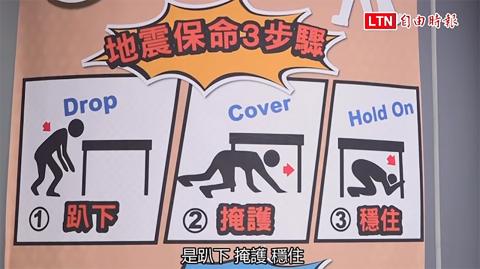Taiwan suffers frequent earthquakes, due to its location within a plate collision zone. People here should therefore be aware of disaster prevention advice in order to keep themselves safe. In the event of an earthquake, or on receiving an earthquake warning announcement, certain steps should be followed. Experts advise a four-step safety procedure: Take cover; open doors; turn off electricity and gas; exit the building.
1. Take cover
When an earthquake hits, personal safety is the priority. Immediately take cover and ensure your head is protected. The three steps to be followed for seeking cover are “drop, find cover, and hold on,” for example by dropping to the floor, taking cover under a solid table, and holding on to a table leg for stability. If outdoors, to avoid being hit by falling signs, seek shelter immediately and squat down until the tremor stops. If driving, bring the vehicle to a stop at the side of the road and turn off the engine until such time as the shaking stops.

Photo: Screengrab from Youtube
照片:截圖自Youtube
One misconception is the so-called “triangle of life,” described in certain widely circulated e-mails and which recommends finding space beside a piece of furniture. The problem is that it is impossible to predict the direction in which a building or piece of furniture will fall during an earthquake. The most sensible solution is to take cover under a solid table.
2. Open doors
Door frames may become broken or misshapen during earthquakes, making it impossible to open the door when you need to escape. If you are within reaching distance of the door when the earthquake begins, open it. However, if you are some distance away, prioritize your personal safety and take cover in the first instance, going to open the door only when the shaking stops.
3. Turn power off
If you are near the power switch or gas valve when the shaking starts, turn off the power. Again, if you are not in their immediate vicinity, the focus should be on your own safety.
4. Escape
Do not attempt to run out of the building until the shaking stops. When it does, find an open space, away from buildings with cracks. Make sure the aftershocks have stopped before returning home.
In addition to these safety tips, each household should prepare an emergency bag for each member of the family to carry with them should it be deemed unsafe to remain at home. Each bag should contain cookies and water sufficient for three days use, a flashlight and whistle, and anything else that might be needed. The emergency bag is also useful to keep anyone unfortunate enough to be trapped alive until such time as they are rescued.
(Liberty Times, translated by Lin Lee-kai)
台灣位於板塊碰撞帶上,常有地震發生,民眾應隨時將防災資訊謹記於心,將傷害減到最低。遇到地震,我們該如何自保呢?專家提供四字口訣「躲、開、關、逃」,一起來看看如何實行吧!
1.躲
地震來襲時,最重要的就是確保自身安全,因此應該立刻尋找掩護,並且護住頭部。躲藏時有三步驟,就是「趴下、掩護、穩住」——應立刻趴下,躲進堅固的桌子下,並且抓住桌子的一腳以求穩固。如果人在戶外,為避免被掉落的招牌砸傷,也應該立刻尋找遮蔽處,並蹲下直到地震停止。如果正在開車,則應該把車子緩慢停至路邊,將車子熄火等到搖晃停止。
網傳地震時有「黃金三角」,說只要躲在家具的一側,就能夠確保存活空間。但這是錯誤的觀念,因為地震時並無法預測建築或家具的倒塌方向,有可能反而被倒塌的家具壓傷。找到堅固的桌子躲避才是最正確的解決之道。
2.開
為了避免地震時,門框被壓壞而變形,導致無法逃生,因此若地震時人在門邊,應把門打開。但如果人不在門旁邊,則應該以自身安全為主,首先找到躲避處,等地震停止後才開門。
3.關
如果地震發生時,人在電源或瓦斯附近,應順手關閉電源及瓦斯。同樣地,如果人不在這些東西附近,則應該以自身安全為主。
4.逃
逃生務必要在地震停止後才執行,地震時千萬不要貿然離開家中。地震停止後,最好前往空曠處,遠離有裂縫的建築,確認餘震都停止後才回家。
除了逃生口訣,每個家庭應每人準備一包緊急救難包放在門口,在發現家中不宜久留時帶著離開,其中至少要包含三天份的餅乾口糧、三天份的水、手電筒以及口哨,其他則依個人需求增減。如果不幸受困,緊急救難包也可以爭取多一點的時間等待搜救。
(自由時報)

In an effort to fight phone scams, British mobile phone company O2 has introduced Daisy, an AI designed to engage phone con artists in time-wasting conversations. Daisy is portrayed as a kindly British granny, exploiting scammers’ tendency to target the elderly. Her voice, based on a real grandmother’s for authenticity, adds to her credibility in the role. “O2” has distributed several dedicated phone numbers online to direct scammers to Daisy instead of actual customers. When Daisy receives a call, she translates the scammers’ spoken words into text and then responds to them accordingly through a text-to-speech system. Remarkably, Daisy

Bilingual Story is a fictionalized account. 雙語故事部分內容純屬虛構。 Emma had reviewed 41 resumes that morning. While the ATS screened out 288 unqualified, she screened for AI slop. She could spot it a mile away. She muttered AI buzzwords like curses under her breath. “Team player.” “Results-driven.” “Stakeholder alignment.” “Leveraging core competencies.” Each resume reeked of AI modeling: a cemetery of cliches, tombstones of personality. AI wasn’t just changing hiring. It was draining the humanity from it. Then she found it: a plain PDF cover letter. No template. No design flourishes. The first line read: “I once tried to automate my

Every May 1, Hawaii comes alive with Lei Day, a festival celebrating the rich culture and spirit of the islands. Initiated in 1927 by the poet Don Blanding, Lei Day began as a tribute to the Hawaiian custom of making and wearing leis. The idea was quickly adopted and officially recognized as a holiday in 1929, and leis have since become a symbol of local pride and cultural preservation. In Hawaiian culture, leis are more than decorative garlands made from flowers, shells or feathers. For Hawaiians, giving a lei is as natural as saying “aloha.” It shows love and

1. 他走出門,左右看一下,就過了馬路。 ˇ He walked outside, looked left and right, and crossed the road. χ He walked outside and looked left and right, crossed the road. 註︰並列連接詞 and 在這句中連接三個述語。一般的結構是 x, y, and z。x and y and z 是加強語氣的結構,x and y, z 則不可以。 2. 他們知道自己的弱點以及如何趕上其他競爭者。 ˇ They saw where their weak points lay and how they could catch up with the other competitors. χ They saw where their weak points lay and how to catch up with the other competitors. 註:and 一般連接同等成分,結構相等的單詞、片語或子句。誤句中 and 的前面是子句,後面是不定詞片語,不能用 and 連接,必須把不定詞片語改為子句,and 前後的結構才相等。 3. 她坐上計程車,直接到機場。 ˇ She took a cab, which took her straight to the airport. ˇ She took a cab and it took her straight